Analysis of Development and Changes in the Oil and Gas Retail Industry
VerifiedAdded on 2020/01/21
|19
|4934
|118
Report
AI Summary
This report provides a comprehensive analysis of the development and recent trends within the oil and gas retail industry, focusing on the UK market. It examines the significant changes in the supply chain, including the closure of petrol filling stations and the rise of supermarket ownership. The report delves into the impact of government and regulatory policies, fiscal drivers, and environmental standards on the industry. It also explores the influence of the North Sea oil production decline, distribution, storage, transportation, and technological advancements. Furthermore, the report highlights changes in buyer behavior, recent trends in refineries, and the competitive pressures faced by traditional oil suppliers. The study concludes with an overview of the changing landscape and the factors shaping the future of the oil and gas retail sector.
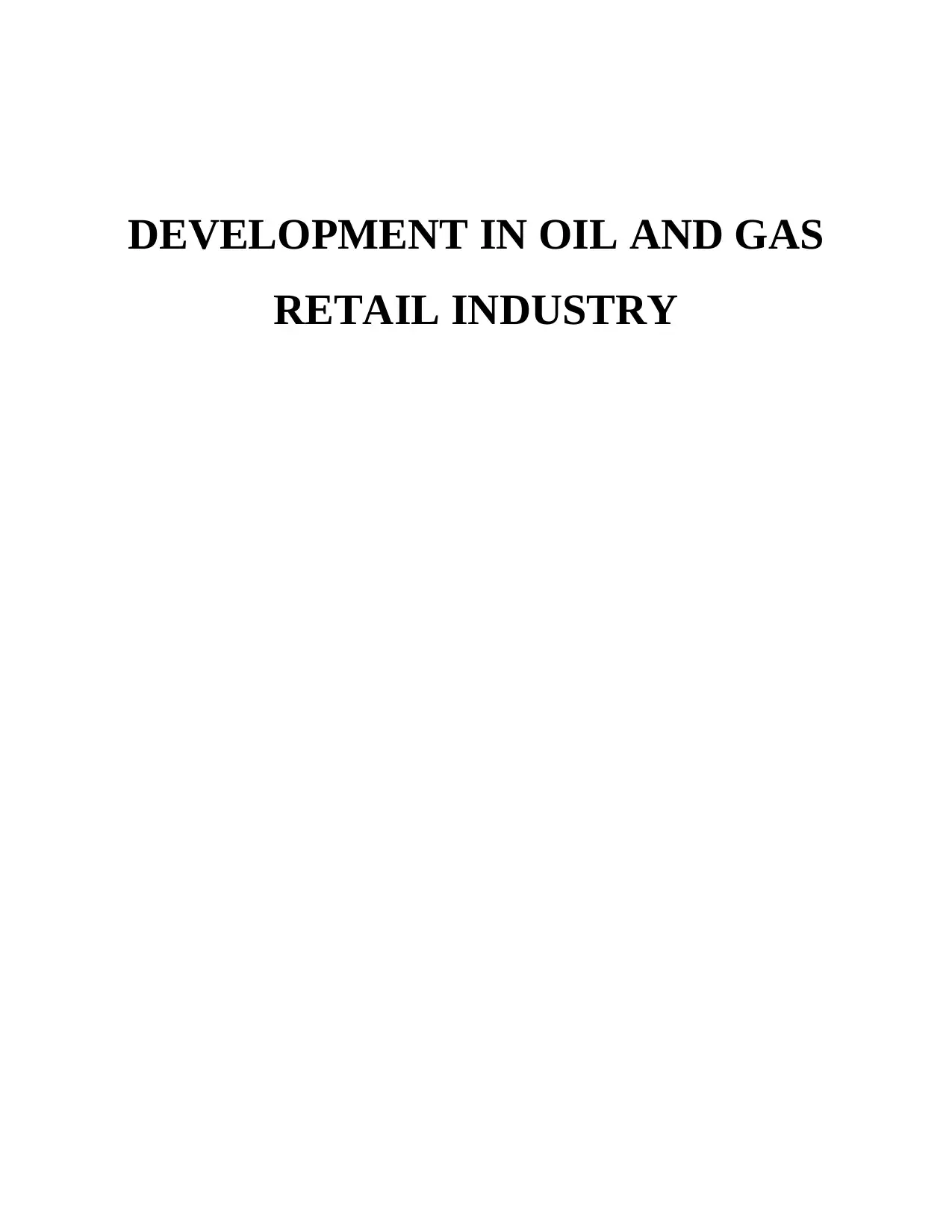
DEVELOPMENT IN OIL AND GAS
RETAIL INDUSTRY
RETAIL INDUSTRY
Paraphrase This Document
Need a fresh take? Get an instant paraphrase of this document with our AI Paraphraser
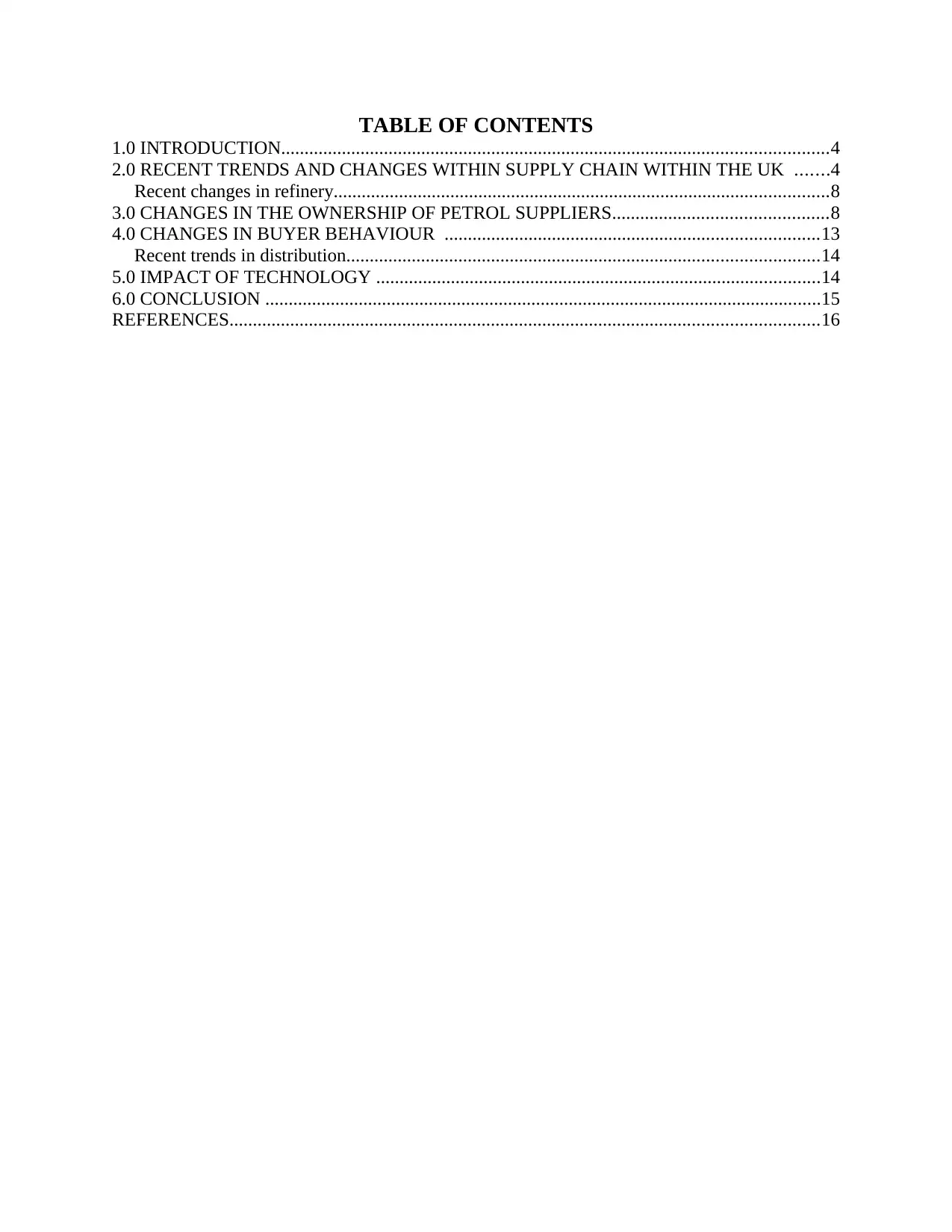
TABLE OF CONTENTS
1.0 INTRODUCTION.....................................................................................................................4
2.0 RECENT TRENDS AND CHANGES WITHIN SUPPLY CHAIN WITHIN THE UK .......4
Recent changes in refinery..........................................................................................................8
3.0 CHANGES IN THE OWNERSHIP OF PETROL SUPPLIERS..............................................8
4.0 CHANGES IN BUYER BEHAVIOUR ................................................................................13
Recent trends in distribution.....................................................................................................14
5.0 IMPACT OF TECHNOLOGY ...............................................................................................14
6.0 CONCLUSION .......................................................................................................................15
REFERENCES..............................................................................................................................16
1.0 INTRODUCTION.....................................................................................................................4
2.0 RECENT TRENDS AND CHANGES WITHIN SUPPLY CHAIN WITHIN THE UK .......4
Recent changes in refinery..........................................................................................................8
3.0 CHANGES IN THE OWNERSHIP OF PETROL SUPPLIERS..............................................8
4.0 CHANGES IN BUYER BEHAVIOUR ................................................................................13
Recent trends in distribution.....................................................................................................14
5.0 IMPACT OF TECHNOLOGY ...............................................................................................14
6.0 CONCLUSION .......................................................................................................................15
REFERENCES..............................................................................................................................16

ILLUSTRATION INDEX
Illustration 1: North Sea Production................................................................................................6
Illustration 2: Declining of PFS in past decades..............................................................................9
Illustration 3: Asda PFS.................................................................................................................11
Illustration 4: Rising of petrol prices of different companies........................................................12
Illustration 5: Total number of PFS and total fuel volumes...........................................................13
Illustration 1: North Sea Production................................................................................................6
Illustration 2: Declining of PFS in past decades..............................................................................9
Illustration 3: Asda PFS.................................................................................................................11
Illustration 4: Rising of petrol prices of different companies........................................................12
Illustration 5: Total number of PFS and total fuel volumes...........................................................13
⊘ This is a preview!⊘
Do you want full access?
Subscribe today to unlock all pages.

Trusted by 1+ million students worldwide
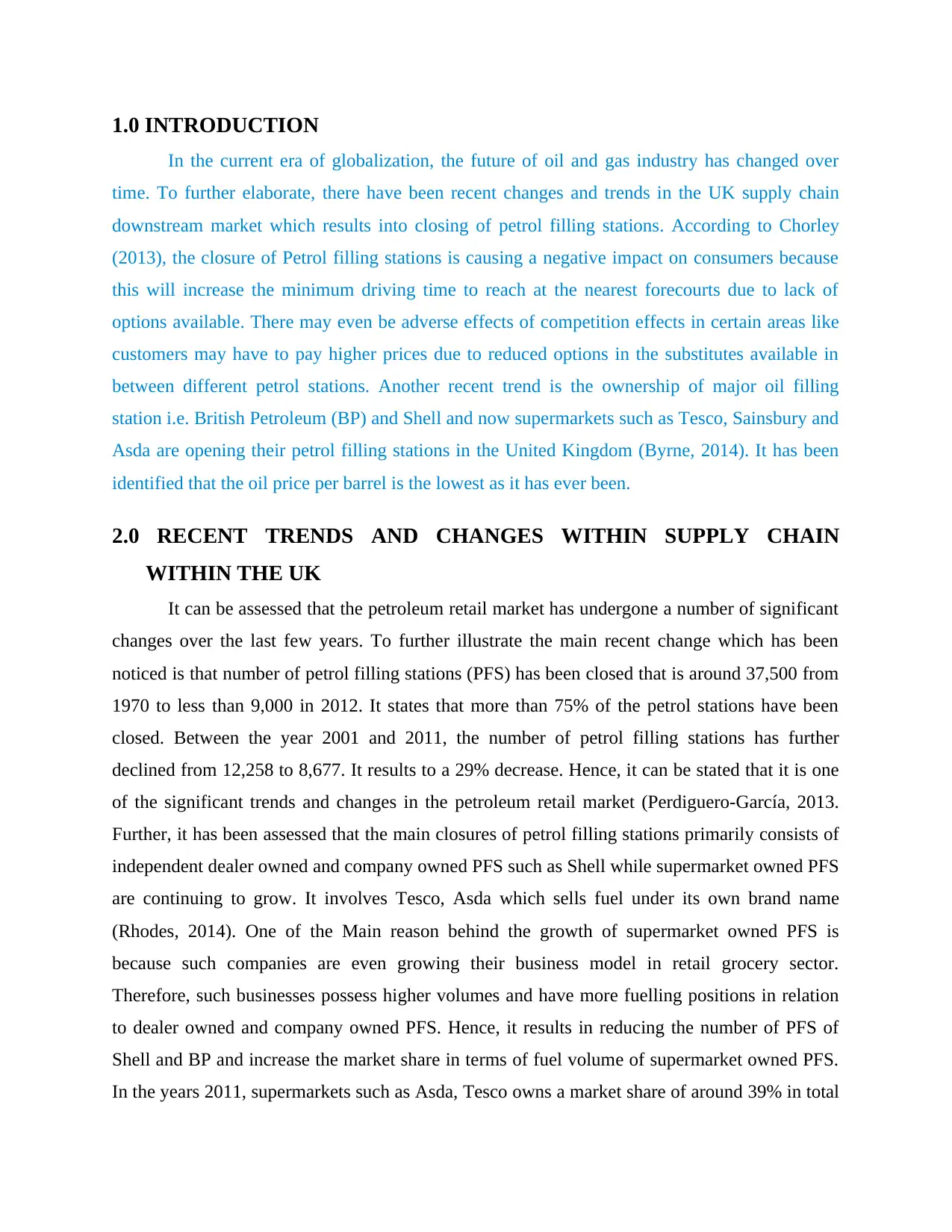
1.0 INTRODUCTION
In the current era of globalization, the future of oil and gas industry has changed over
time. To further elaborate, there have been recent changes and trends in the UK supply chain
downstream market which results into closing of petrol filling stations. According to Chorley
(2013), the closure of Petrol filling stations is causing a negative impact on consumers because
this will increase the minimum driving time to reach at the nearest forecourts due to lack of
options available. There may even be adverse effects of competition effects in certain areas like
customers may have to pay higher prices due to reduced options in the substitutes available in
between different petrol stations. Another recent trend is the ownership of major oil filling
station i.e. British Petroleum (BP) and Shell and now supermarkets such as Tesco, Sainsbury and
Asda are opening their petrol filling stations in the United Kingdom (Byrne, 2014). It has been
identified that the oil price per barrel is the lowest as it has ever been.
2.0 RECENT TRENDS AND CHANGES WITHIN SUPPLY CHAIN
WITHIN THE UK
It can be assessed that the petroleum retail market has undergone a number of significant
changes over the last few years. To further illustrate the main recent change which has been
noticed is that number of petrol filling stations (PFS) has been closed that is around 37,500 from
1970 to less than 9,000 in 2012. It states that more than 75% of the petrol stations have been
closed. Between the year 2001 and 2011, the number of petrol filling stations has further
declined from 12,258 to 8,677. It results to a 29% decrease. Hence, it can be stated that it is one
of the significant trends and changes in the petroleum retail market (Perdiguero-García, 2013.
Further, it has been assessed that the main closures of petrol filling stations primarily consists of
independent dealer owned and company owned PFS such as Shell while supermarket owned PFS
are continuing to grow. It involves Tesco, Asda which sells fuel under its own brand name
(Rhodes, 2014). One of the Main reason behind the growth of supermarket owned PFS is
because such companies are even growing their business model in retail grocery sector.
Therefore, such businesses possess higher volumes and have more fuelling positions in relation
to dealer owned and company owned PFS. Hence, it results in reducing the number of PFS of
Shell and BP and increase the market share in terms of fuel volume of supermarket owned PFS.
In the years 2011, supermarkets such as Asda, Tesco owns a market share of around 39% in total
In the current era of globalization, the future of oil and gas industry has changed over
time. To further elaborate, there have been recent changes and trends in the UK supply chain
downstream market which results into closing of petrol filling stations. According to Chorley
(2013), the closure of Petrol filling stations is causing a negative impact on consumers because
this will increase the minimum driving time to reach at the nearest forecourts due to lack of
options available. There may even be adverse effects of competition effects in certain areas like
customers may have to pay higher prices due to reduced options in the substitutes available in
between different petrol stations. Another recent trend is the ownership of major oil filling
station i.e. British Petroleum (BP) and Shell and now supermarkets such as Tesco, Sainsbury and
Asda are opening their petrol filling stations in the United Kingdom (Byrne, 2014). It has been
identified that the oil price per barrel is the lowest as it has ever been.
2.0 RECENT TRENDS AND CHANGES WITHIN SUPPLY CHAIN
WITHIN THE UK
It can be assessed that the petroleum retail market has undergone a number of significant
changes over the last few years. To further illustrate the main recent change which has been
noticed is that number of petrol filling stations (PFS) has been closed that is around 37,500 from
1970 to less than 9,000 in 2012. It states that more than 75% of the petrol stations have been
closed. Between the year 2001 and 2011, the number of petrol filling stations has further
declined from 12,258 to 8,677. It results to a 29% decrease. Hence, it can be stated that it is one
of the significant trends and changes in the petroleum retail market (Perdiguero-García, 2013.
Further, it has been assessed that the main closures of petrol filling stations primarily consists of
independent dealer owned and company owned PFS such as Shell while supermarket owned PFS
are continuing to grow. It involves Tesco, Asda which sells fuel under its own brand name
(Rhodes, 2014). One of the Main reason behind the growth of supermarket owned PFS is
because such companies are even growing their business model in retail grocery sector.
Therefore, such businesses possess higher volumes and have more fuelling positions in relation
to dealer owned and company owned PFS. Hence, it results in reducing the number of PFS of
Shell and BP and increase the market share in terms of fuel volume of supermarket owned PFS.
In the years 2011, supermarkets such as Asda, Tesco owns a market share of around 39% in total
Paraphrase This Document
Need a fresh take? Get an instant paraphrase of this document with our AI Paraphraser
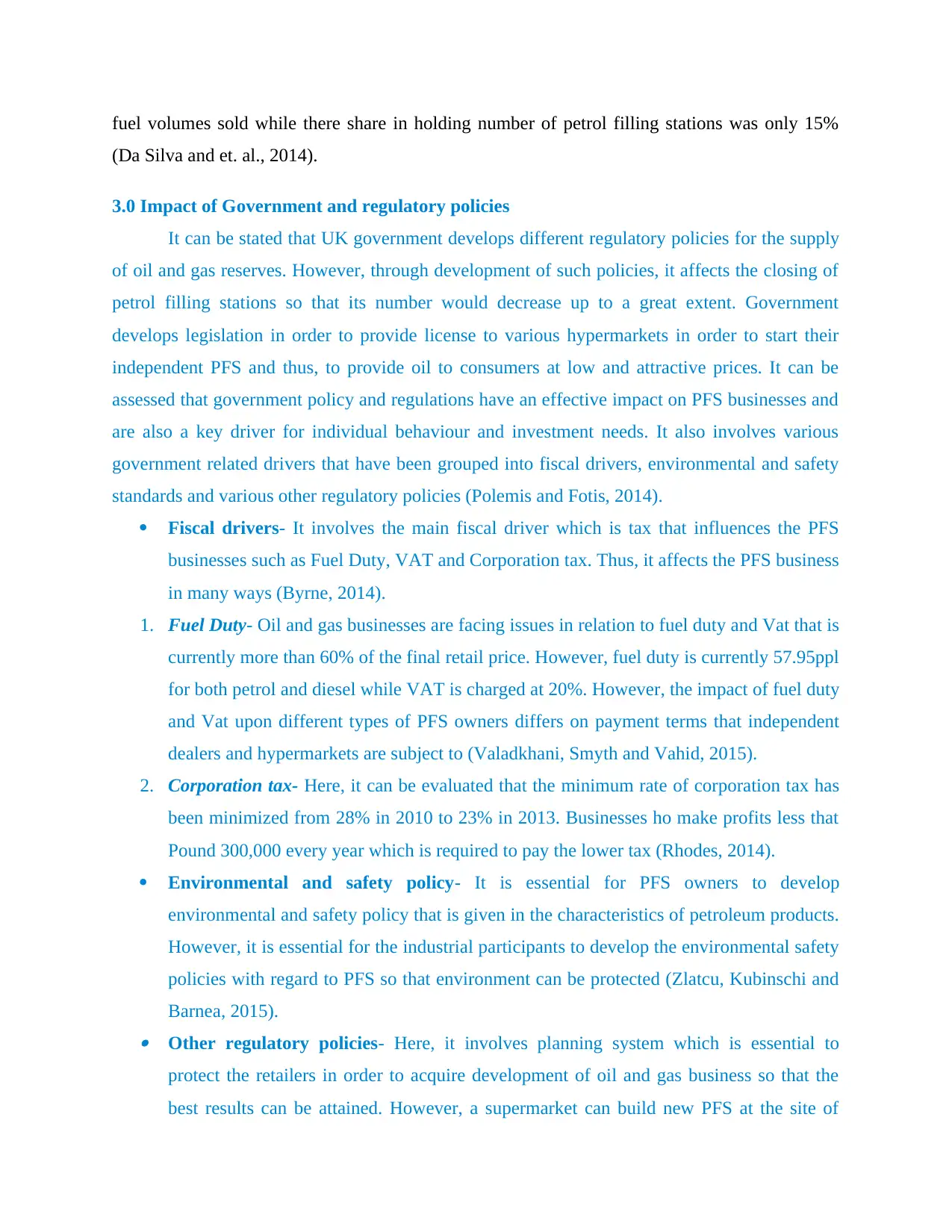
fuel volumes sold while there share in holding number of petrol filling stations was only 15%
(Da Silva and et. al., 2014).
3.0 Impact of Government and regulatory policies
It can be stated that UK government develops different regulatory policies for the supply
of oil and gas reserves. However, through development of such policies, it affects the closing of
petrol filling stations so that its number would decrease up to a great extent. Government
develops legislation in order to provide license to various hypermarkets in order to start their
independent PFS and thus, to provide oil to consumers at low and attractive prices. It can be
assessed that government policy and regulations have an effective impact on PFS businesses and
are also a key driver for individual behaviour and investment needs. It also involves various
government related drivers that have been grouped into fiscal drivers, environmental and safety
standards and various other regulatory policies (Polemis and Fotis, 2014).
Fiscal drivers- It involves the main fiscal driver which is tax that influences the PFS
businesses such as Fuel Duty, VAT and Corporation tax. Thus, it affects the PFS business
in many ways (Byrne, 2014).
1. Fuel Duty- Oil and gas businesses are facing issues in relation to fuel duty and Vat that is
currently more than 60% of the final retail price. However, fuel duty is currently 57.95ppl
for both petrol and diesel while VAT is charged at 20%. However, the impact of fuel duty
and Vat upon different types of PFS owners differs on payment terms that independent
dealers and hypermarkets are subject to (Valadkhani, Smyth and Vahid, 2015).
2. Corporation tax- Here, it can be evaluated that the minimum rate of corporation tax has
been minimized from 28% in 2010 to 23% in 2013. Businesses ho make profits less that
Pound 300,000 every year which is required to pay the lower tax (Rhodes, 2014).
Environmental and safety policy- It is essential for PFS owners to develop
environmental and safety policy that is given in the characteristics of petroleum products.
However, it is essential for the industrial participants to develop the environmental safety
policies with regard to PFS so that environment can be protected (Zlatcu, Kubinschi and
Barnea, 2015). Other regulatory policies- Here, it involves planning system which is essential to
protect the retailers in order to acquire development of oil and gas business so that the
best results can be attained. However, a supermarket can build new PFS at the site of
(Da Silva and et. al., 2014).
3.0 Impact of Government and regulatory policies
It can be stated that UK government develops different regulatory policies for the supply
of oil and gas reserves. However, through development of such policies, it affects the closing of
petrol filling stations so that its number would decrease up to a great extent. Government
develops legislation in order to provide license to various hypermarkets in order to start their
independent PFS and thus, to provide oil to consumers at low and attractive prices. It can be
assessed that government policy and regulations have an effective impact on PFS businesses and
are also a key driver for individual behaviour and investment needs. It also involves various
government related drivers that have been grouped into fiscal drivers, environmental and safety
standards and various other regulatory policies (Polemis and Fotis, 2014).
Fiscal drivers- It involves the main fiscal driver which is tax that influences the PFS
businesses such as Fuel Duty, VAT and Corporation tax. Thus, it affects the PFS business
in many ways (Byrne, 2014).
1. Fuel Duty- Oil and gas businesses are facing issues in relation to fuel duty and Vat that is
currently more than 60% of the final retail price. However, fuel duty is currently 57.95ppl
for both petrol and diesel while VAT is charged at 20%. However, the impact of fuel duty
and Vat upon different types of PFS owners differs on payment terms that independent
dealers and hypermarkets are subject to (Valadkhani, Smyth and Vahid, 2015).
2. Corporation tax- Here, it can be evaluated that the minimum rate of corporation tax has
been minimized from 28% in 2010 to 23% in 2013. Businesses ho make profits less that
Pound 300,000 every year which is required to pay the lower tax (Rhodes, 2014).
Environmental and safety policy- It is essential for PFS owners to develop
environmental and safety policy that is given in the characteristics of petroleum products.
However, it is essential for the industrial participants to develop the environmental safety
policies with regard to PFS so that environment can be protected (Zlatcu, Kubinschi and
Barnea, 2015). Other regulatory policies- Here, it involves planning system which is essential to
protect the retailers in order to acquire development of oil and gas business so that the
best results can be attained. However, a supermarket can build new PFS at the site of
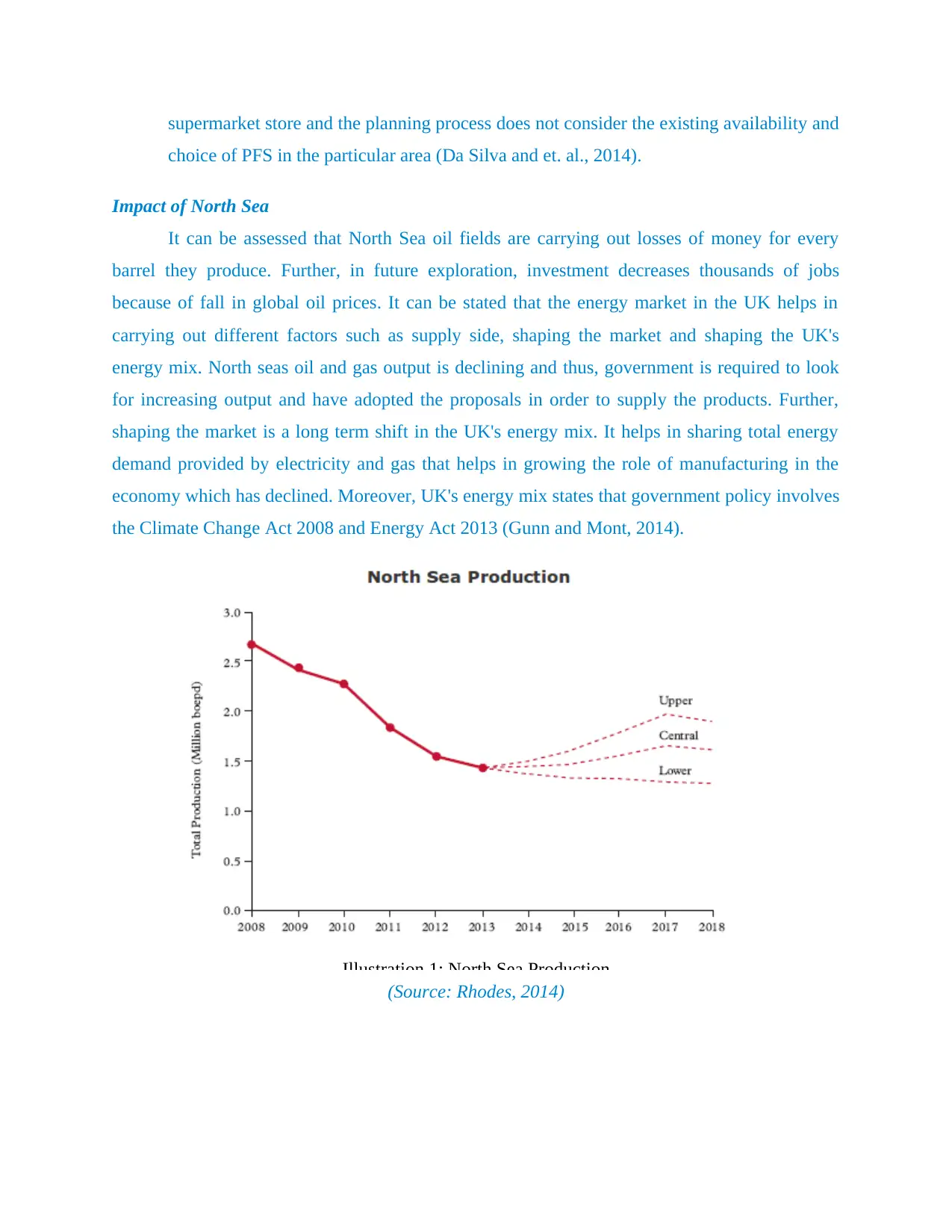
supermarket store and the planning process does not consider the existing availability and
choice of PFS in the particular area (Da Silva and et. al., 2014).
Impact of North Sea
It can be assessed that North Sea oil fields are carrying out losses of money for every
barrel they produce. Further, in future exploration, investment decreases thousands of jobs
because of fall in global oil prices. It can be stated that the energy market in the UK helps in
carrying out different factors such as supply side, shaping the market and shaping the UK's
energy mix. North seas oil and gas output is declining and thus, government is required to look
for increasing output and have adopted the proposals in order to supply the products. Further,
shaping the market is a long term shift in the UK's energy mix. It helps in sharing total energy
demand provided by electricity and gas that helps in growing the role of manufacturing in the
economy which has declined. Moreover, UK's energy mix states that government policy involves
the Climate Change Act 2008 and Energy Act 2013 (Gunn and Mont, 2014).
Illustration 1: North Sea Production
(Source: Rhodes, 2014)
choice of PFS in the particular area (Da Silva and et. al., 2014).
Impact of North Sea
It can be assessed that North Sea oil fields are carrying out losses of money for every
barrel they produce. Further, in future exploration, investment decreases thousands of jobs
because of fall in global oil prices. It can be stated that the energy market in the UK helps in
carrying out different factors such as supply side, shaping the market and shaping the UK's
energy mix. North seas oil and gas output is declining and thus, government is required to look
for increasing output and have adopted the proposals in order to supply the products. Further,
shaping the market is a long term shift in the UK's energy mix. It helps in sharing total energy
demand provided by electricity and gas that helps in growing the role of manufacturing in the
economy which has declined. Moreover, UK's energy mix states that government policy involves
the Climate Change Act 2008 and Energy Act 2013 (Gunn and Mont, 2014).
Illustration 1: North Sea Production
(Source: Rhodes, 2014)
⊘ This is a preview!⊘
Do you want full access?
Subscribe today to unlock all pages.

Trusted by 1+ million students worldwide
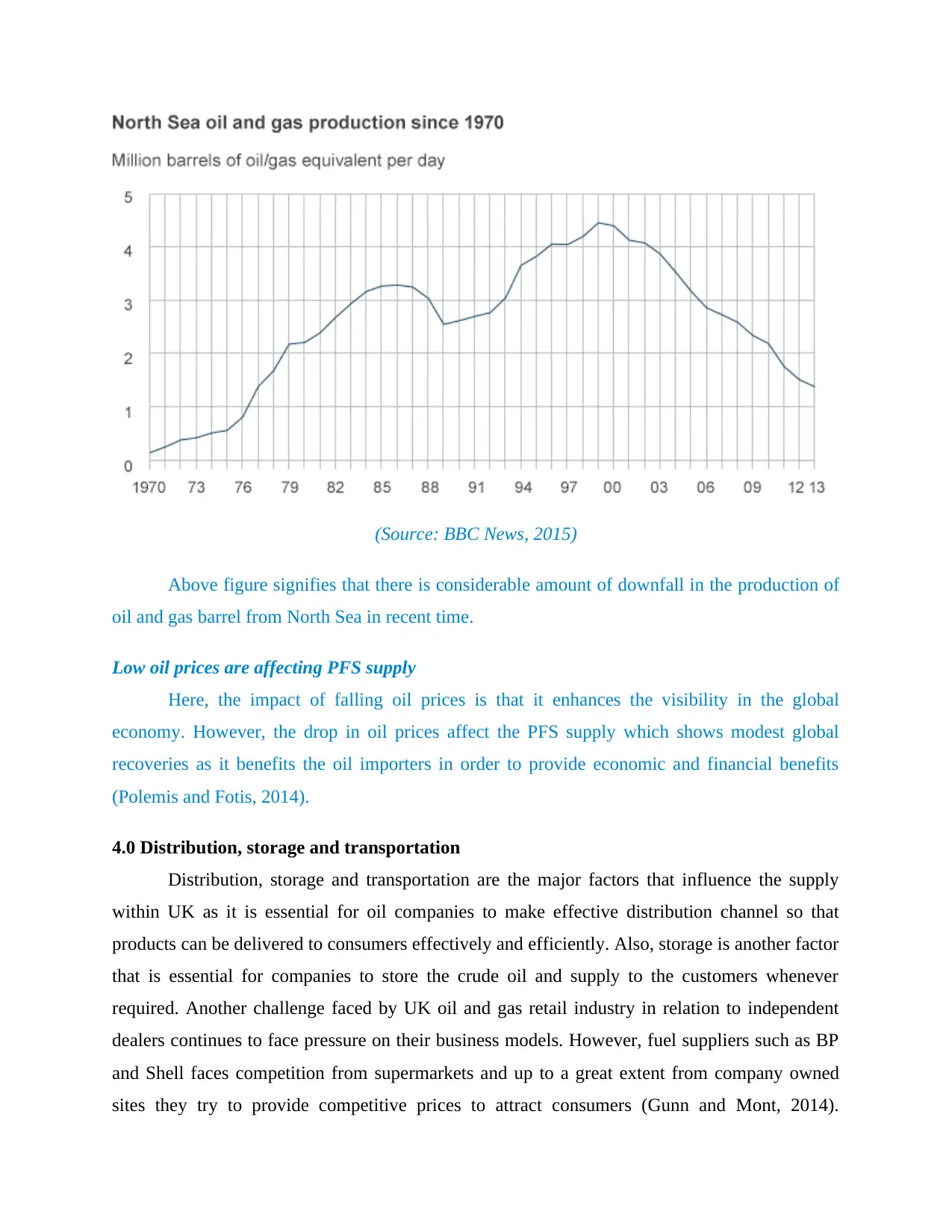
(Source: BBC News, 2015)
Above figure signifies that there is considerable amount of downfall in the production of
oil and gas barrel from North Sea in recent time.
Low oil prices are affecting PFS supply
Here, the impact of falling oil prices is that it enhances the visibility in the global
economy. However, the drop in oil prices affect the PFS supply which shows modest global
recoveries as it benefits the oil importers in order to provide economic and financial benefits
(Polemis and Fotis, 2014).
4.0 Distribution, storage and transportation
Distribution, storage and transportation are the major factors that influence the supply
within UK as it is essential for oil companies to make effective distribution channel so that
products can be delivered to consumers effectively and efficiently. Also, storage is another factor
that is essential for companies to store the crude oil and supply to the customers whenever
required. Another challenge faced by UK oil and gas retail industry in relation to independent
dealers continues to face pressure on their business models. However, fuel suppliers such as BP
and Shell faces competition from supermarkets and up to a great extent from company owned
sites they try to provide competitive prices to attract consumers (Gunn and Mont, 2014).
Above figure signifies that there is considerable amount of downfall in the production of
oil and gas barrel from North Sea in recent time.
Low oil prices are affecting PFS supply
Here, the impact of falling oil prices is that it enhances the visibility in the global
economy. However, the drop in oil prices affect the PFS supply which shows modest global
recoveries as it benefits the oil importers in order to provide economic and financial benefits
(Polemis and Fotis, 2014).
4.0 Distribution, storage and transportation
Distribution, storage and transportation are the major factors that influence the supply
within UK as it is essential for oil companies to make effective distribution channel so that
products can be delivered to consumers effectively and efficiently. Also, storage is another factor
that is essential for companies to store the crude oil and supply to the customers whenever
required. Another challenge faced by UK oil and gas retail industry in relation to independent
dealers continues to face pressure on their business models. However, fuel suppliers such as BP
and Shell faces competition from supermarkets and up to a great extent from company owned
sites they try to provide competitive prices to attract consumers (Gunn and Mont, 2014).
Paraphrase This Document
Need a fresh take? Get an instant paraphrase of this document with our AI Paraphraser
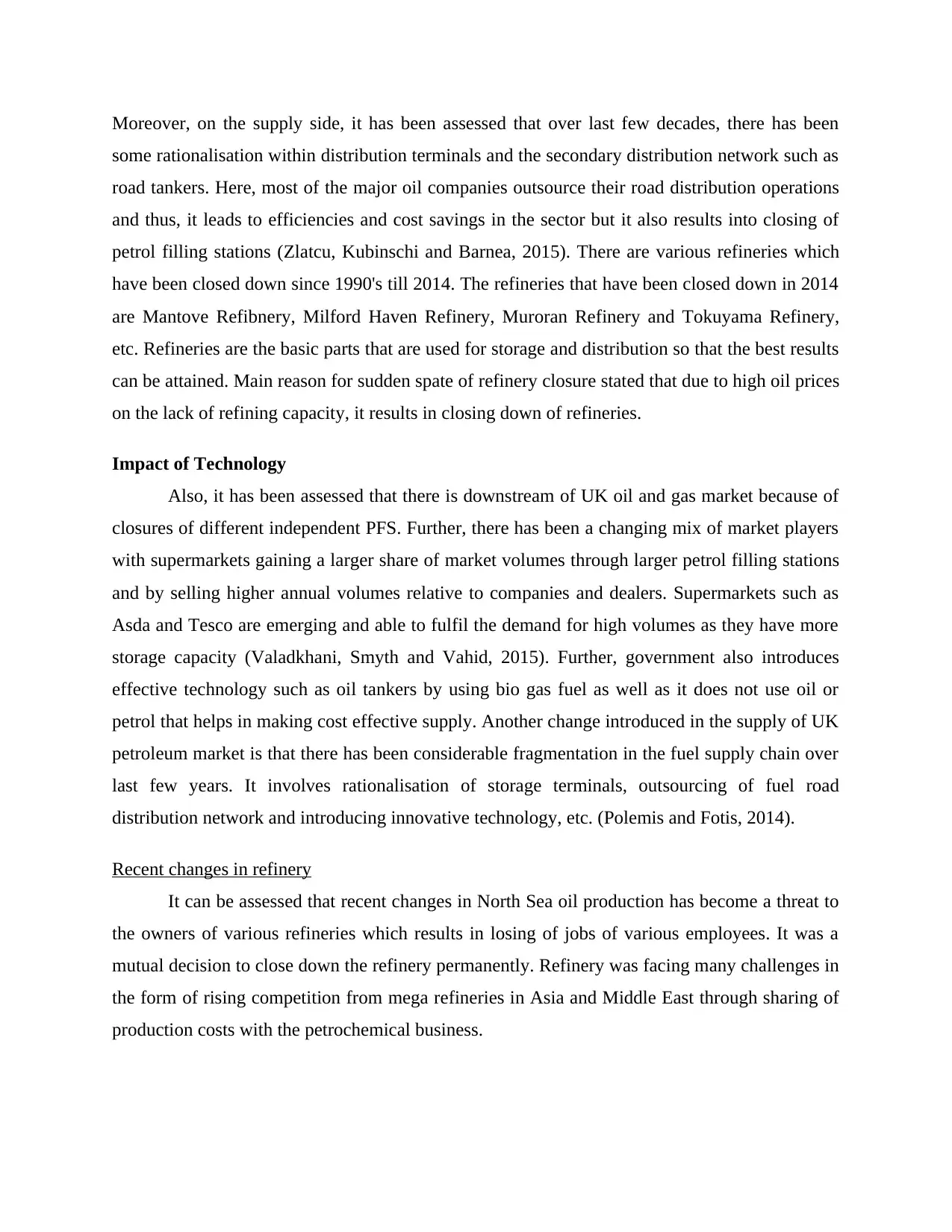
Moreover, on the supply side, it has been assessed that over last few decades, there has been
some rationalisation within distribution terminals and the secondary distribution network such as
road tankers. Here, most of the major oil companies outsource their road distribution operations
and thus, it leads to efficiencies and cost savings in the sector but it also results into closing of
petrol filling stations (Zlatcu, Kubinschi and Barnea, 2015). There are various refineries which
have been closed down since 1990's till 2014. The refineries that have been closed down in 2014
are Mantove Refibnery, Milford Haven Refinery, Muroran Refinery and Tokuyama Refinery,
etc. Refineries are the basic parts that are used for storage and distribution so that the best results
can be attained. Main reason for sudden spate of refinery closure stated that due to high oil prices
on the lack of refining capacity, it results in closing down of refineries.
Impact of Technology
Also, it has been assessed that there is downstream of UK oil and gas market because of
closures of different independent PFS. Further, there has been a changing mix of market players
with supermarkets gaining a larger share of market volumes through larger petrol filling stations
and by selling higher annual volumes relative to companies and dealers. Supermarkets such as
Asda and Tesco are emerging and able to fulfil the demand for high volumes as they have more
storage capacity (Valadkhani, Smyth and Vahid, 2015). Further, government also introduces
effective technology such as oil tankers by using bio gas fuel as well as it does not use oil or
petrol that helps in making cost effective supply. Another change introduced in the supply of UK
petroleum market is that there has been considerable fragmentation in the fuel supply chain over
last few years. It involves rationalisation of storage terminals, outsourcing of fuel road
distribution network and introducing innovative technology, etc. (Polemis and Fotis, 2014).
Recent changes in refinery
It can be assessed that recent changes in North Sea oil production has become a threat to
the owners of various refineries which results in losing of jobs of various employees. It was a
mutual decision to close down the refinery permanently. Refinery was facing many challenges in
the form of rising competition from mega refineries in Asia and Middle East through sharing of
production costs with the petrochemical business.
some rationalisation within distribution terminals and the secondary distribution network such as
road tankers. Here, most of the major oil companies outsource their road distribution operations
and thus, it leads to efficiencies and cost savings in the sector but it also results into closing of
petrol filling stations (Zlatcu, Kubinschi and Barnea, 2015). There are various refineries which
have been closed down since 1990's till 2014. The refineries that have been closed down in 2014
are Mantove Refibnery, Milford Haven Refinery, Muroran Refinery and Tokuyama Refinery,
etc. Refineries are the basic parts that are used for storage and distribution so that the best results
can be attained. Main reason for sudden spate of refinery closure stated that due to high oil prices
on the lack of refining capacity, it results in closing down of refineries.
Impact of Technology
Also, it has been assessed that there is downstream of UK oil and gas market because of
closures of different independent PFS. Further, there has been a changing mix of market players
with supermarkets gaining a larger share of market volumes through larger petrol filling stations
and by selling higher annual volumes relative to companies and dealers. Supermarkets such as
Asda and Tesco are emerging and able to fulfil the demand for high volumes as they have more
storage capacity (Valadkhani, Smyth and Vahid, 2015). Further, government also introduces
effective technology such as oil tankers by using bio gas fuel as well as it does not use oil or
petrol that helps in making cost effective supply. Another change introduced in the supply of UK
petroleum market is that there has been considerable fragmentation in the fuel supply chain over
last few years. It involves rationalisation of storage terminals, outsourcing of fuel road
distribution network and introducing innovative technology, etc. (Polemis and Fotis, 2014).
Recent changes in refinery
It can be assessed that recent changes in North Sea oil production has become a threat to
the owners of various refineries which results in losing of jobs of various employees. It was a
mutual decision to close down the refinery permanently. Refinery was facing many challenges in
the form of rising competition from mega refineries in Asia and Middle East through sharing of
production costs with the petrochemical business.
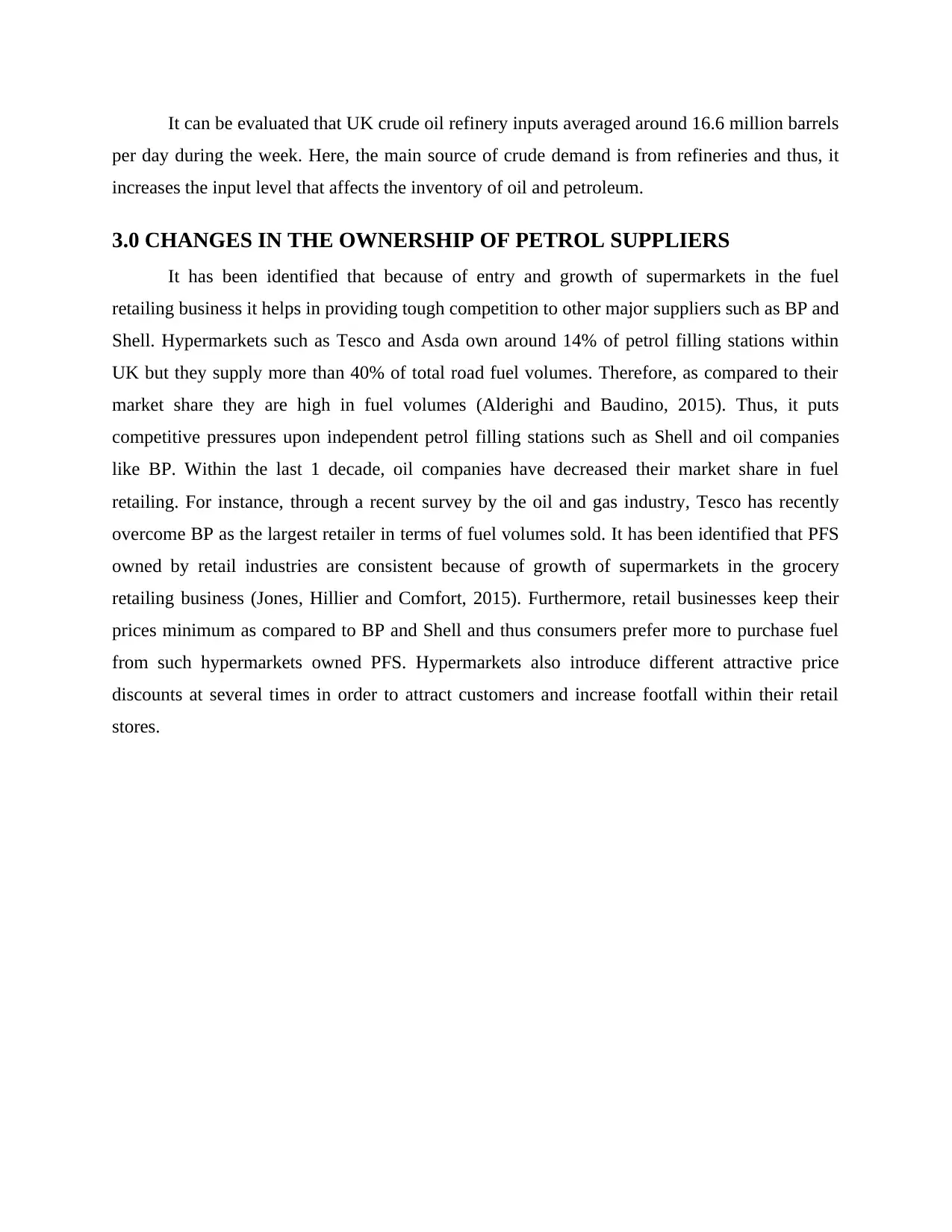
It can be evaluated that UK crude oil refinery inputs averaged around 16.6 million barrels
per day during the week. Here, the main source of crude demand is from refineries and thus, it
increases the input level that affects the inventory of oil and petroleum.
3.0 CHANGES IN THE OWNERSHIP OF PETROL SUPPLIERS
It has been identified that because of entry and growth of supermarkets in the fuel
retailing business it helps in providing tough competition to other major suppliers such as BP and
Shell. Hypermarkets such as Tesco and Asda own around 14% of petrol filling stations within
UK but they supply more than 40% of total road fuel volumes. Therefore, as compared to their
market share they are high in fuel volumes (Alderighi and Baudino, 2015). Thus, it puts
competitive pressures upon independent petrol filling stations such as Shell and oil companies
like BP. Within the last 1 decade, oil companies have decreased their market share in fuel
retailing. For instance, through a recent survey by the oil and gas industry, Tesco has recently
overcome BP as the largest retailer in terms of fuel volumes sold. It has been identified that PFS
owned by retail industries are consistent because of growth of supermarkets in the grocery
retailing business (Jones, Hillier and Comfort, 2015). Furthermore, retail businesses keep their
prices minimum as compared to BP and Shell and thus consumers prefer more to purchase fuel
from such hypermarkets owned PFS. Hypermarkets also introduce different attractive price
discounts at several times in order to attract customers and increase footfall within their retail
stores.
per day during the week. Here, the main source of crude demand is from refineries and thus, it
increases the input level that affects the inventory of oil and petroleum.
3.0 CHANGES IN THE OWNERSHIP OF PETROL SUPPLIERS
It has been identified that because of entry and growth of supermarkets in the fuel
retailing business it helps in providing tough competition to other major suppliers such as BP and
Shell. Hypermarkets such as Tesco and Asda own around 14% of petrol filling stations within
UK but they supply more than 40% of total road fuel volumes. Therefore, as compared to their
market share they are high in fuel volumes (Alderighi and Baudino, 2015). Thus, it puts
competitive pressures upon independent petrol filling stations such as Shell and oil companies
like BP. Within the last 1 decade, oil companies have decreased their market share in fuel
retailing. For instance, through a recent survey by the oil and gas industry, Tesco has recently
overcome BP as the largest retailer in terms of fuel volumes sold. It has been identified that PFS
owned by retail industries are consistent because of growth of supermarkets in the grocery
retailing business (Jones, Hillier and Comfort, 2015). Furthermore, retail businesses keep their
prices minimum as compared to BP and Shell and thus consumers prefer more to purchase fuel
from such hypermarkets owned PFS. Hypermarkets also introduce different attractive price
discounts at several times in order to attract customers and increase footfall within their retail
stores.
⊘ This is a preview!⊘
Do you want full access?
Subscribe today to unlock all pages.

Trusted by 1+ million students worldwide
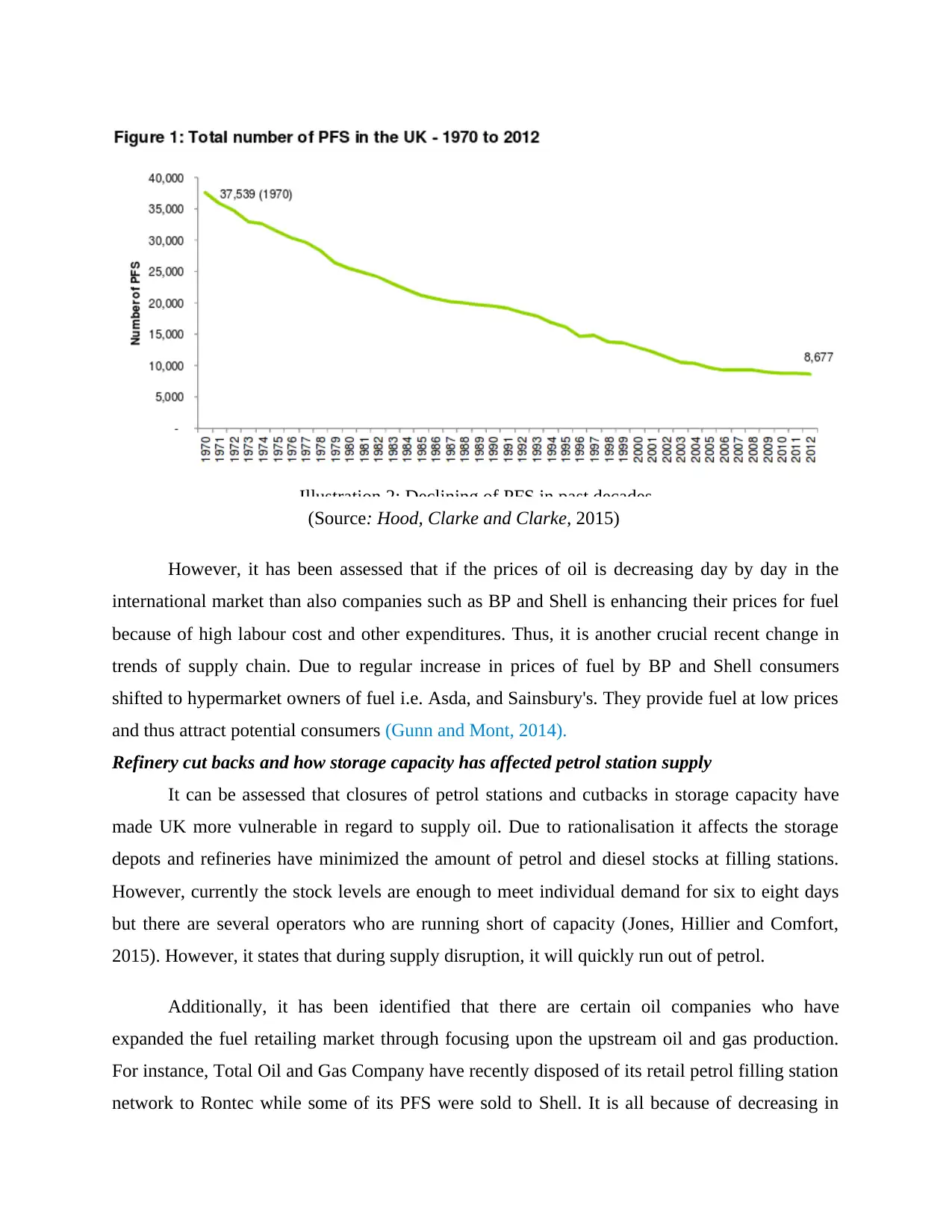
Illustration 2: Declining of PFS in past decades
(Source: Hood, Clarke and Clarke, 2015)
However, it has been assessed that if the prices of oil is decreasing day by day in the
international market than also companies such as BP and Shell is enhancing their prices for fuel
because of high labour cost and other expenditures. Thus, it is another crucial recent change in
trends of supply chain. Due to regular increase in prices of fuel by BP and Shell consumers
shifted to hypermarket owners of fuel i.e. Asda, and Sainsbury's. They provide fuel at low prices
and thus attract potential consumers (Gunn and Mont, 2014).
Refinery cut backs and how storage capacity has affected petrol station supply
It can be assessed that closures of petrol stations and cutbacks in storage capacity have
made UK more vulnerable in regard to supply oil. Due to rationalisation it affects the storage
depots and refineries have minimized the amount of petrol and diesel stocks at filling stations.
However, currently the stock levels are enough to meet individual demand for six to eight days
but there are several operators who are running short of capacity (Jones, Hillier and Comfort,
2015). However, it states that during supply disruption, it will quickly run out of petrol.
Additionally, it has been identified that there are certain oil companies who have
expanded the fuel retailing market through focusing upon the upstream oil and gas production.
For instance, Total Oil and Gas Company have recently disposed of its retail petrol filling station
network to Rontec while some of its PFS were sold to Shell. It is all because of decreasing in
(Source: Hood, Clarke and Clarke, 2015)
However, it has been assessed that if the prices of oil is decreasing day by day in the
international market than also companies such as BP and Shell is enhancing their prices for fuel
because of high labour cost and other expenditures. Thus, it is another crucial recent change in
trends of supply chain. Due to regular increase in prices of fuel by BP and Shell consumers
shifted to hypermarket owners of fuel i.e. Asda, and Sainsbury's. They provide fuel at low prices
and thus attract potential consumers (Gunn and Mont, 2014).
Refinery cut backs and how storage capacity has affected petrol station supply
It can be assessed that closures of petrol stations and cutbacks in storage capacity have
made UK more vulnerable in regard to supply oil. Due to rationalisation it affects the storage
depots and refineries have minimized the amount of petrol and diesel stocks at filling stations.
However, currently the stock levels are enough to meet individual demand for six to eight days
but there are several operators who are running short of capacity (Jones, Hillier and Comfort,
2015). However, it states that during supply disruption, it will quickly run out of petrol.
Additionally, it has been identified that there are certain oil companies who have
expanded the fuel retailing market through focusing upon the upstream oil and gas production.
For instance, Total Oil and Gas Company have recently disposed of its retail petrol filling station
network to Rontec while some of its PFS were sold to Shell. It is all because of decreasing in
Paraphrase This Document
Need a fresh take? Get an instant paraphrase of this document with our AI Paraphraser
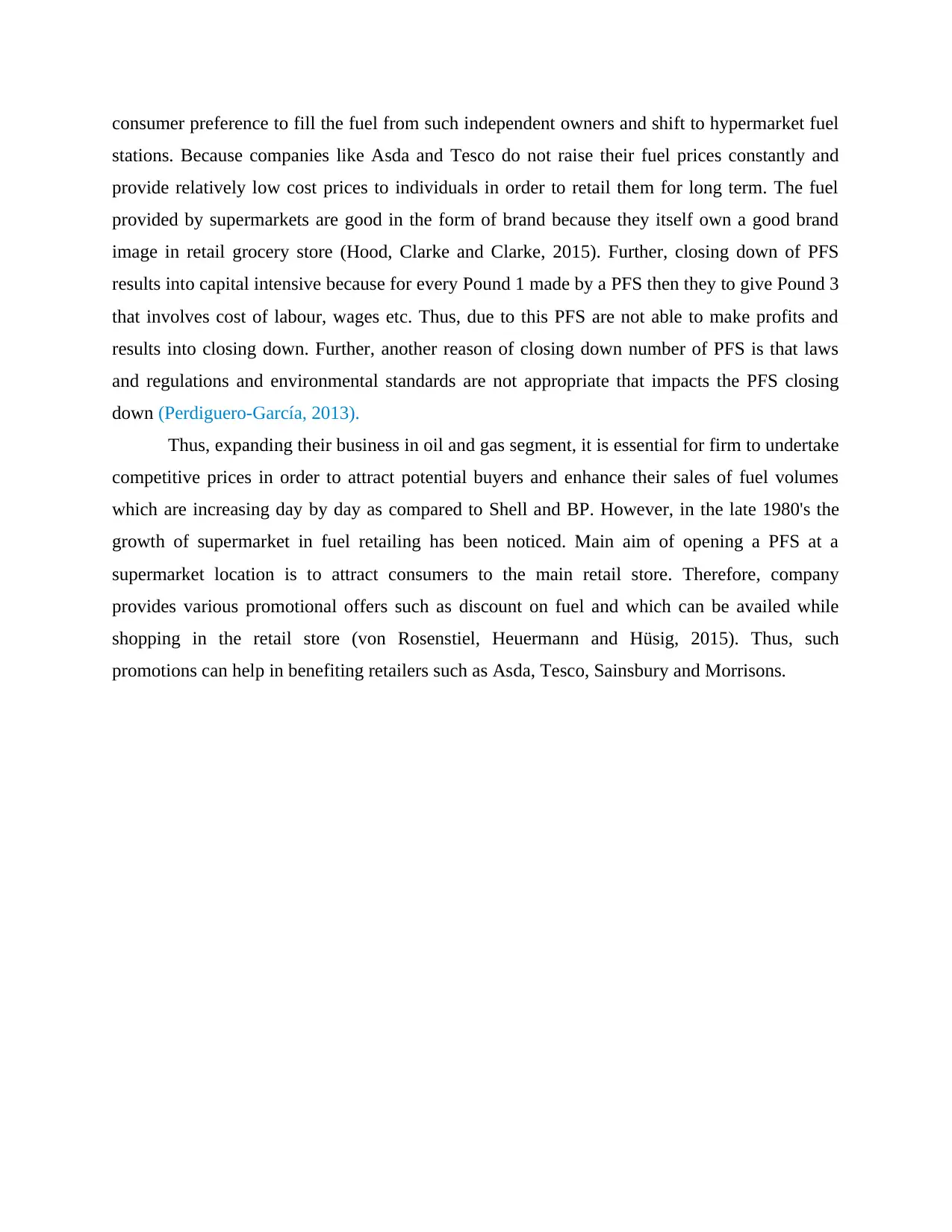
consumer preference to fill the fuel from such independent owners and shift to hypermarket fuel
stations. Because companies like Asda and Tesco do not raise their fuel prices constantly and
provide relatively low cost prices to individuals in order to retail them for long term. The fuel
provided by supermarkets are good in the form of brand because they itself own a good brand
image in retail grocery store (Hood, Clarke and Clarke, 2015). Further, closing down of PFS
results into capital intensive because for every Pound 1 made by a PFS then they to give Pound 3
that involves cost of labour, wages etc. Thus, due to this PFS are not able to make profits and
results into closing down. Further, another reason of closing down number of PFS is that laws
and regulations and environmental standards are not appropriate that impacts the PFS closing
down (Perdiguero-García, 2013).
Thus, expanding their business in oil and gas segment, it is essential for firm to undertake
competitive prices in order to attract potential buyers and enhance their sales of fuel volumes
which are increasing day by day as compared to Shell and BP. However, in the late 1980's the
growth of supermarket in fuel retailing has been noticed. Main aim of opening a PFS at a
supermarket location is to attract consumers to the main retail store. Therefore, company
provides various promotional offers such as discount on fuel and which can be availed while
shopping in the retail store (von Rosenstiel, Heuermann and Hüsig, 2015). Thus, such
promotions can help in benefiting retailers such as Asda, Tesco, Sainsbury and Morrisons.
stations. Because companies like Asda and Tesco do not raise their fuel prices constantly and
provide relatively low cost prices to individuals in order to retail them for long term. The fuel
provided by supermarkets are good in the form of brand because they itself own a good brand
image in retail grocery store (Hood, Clarke and Clarke, 2015). Further, closing down of PFS
results into capital intensive because for every Pound 1 made by a PFS then they to give Pound 3
that involves cost of labour, wages etc. Thus, due to this PFS are not able to make profits and
results into closing down. Further, another reason of closing down number of PFS is that laws
and regulations and environmental standards are not appropriate that impacts the PFS closing
down (Perdiguero-García, 2013).
Thus, expanding their business in oil and gas segment, it is essential for firm to undertake
competitive prices in order to attract potential buyers and enhance their sales of fuel volumes
which are increasing day by day as compared to Shell and BP. However, in the late 1980's the
growth of supermarket in fuel retailing has been noticed. Main aim of opening a PFS at a
supermarket location is to attract consumers to the main retail store. Therefore, company
provides various promotional offers such as discount on fuel and which can be availed while
shopping in the retail store (von Rosenstiel, Heuermann and Hüsig, 2015). Thus, such
promotions can help in benefiting retailers such as Asda, Tesco, Sainsbury and Morrisons.
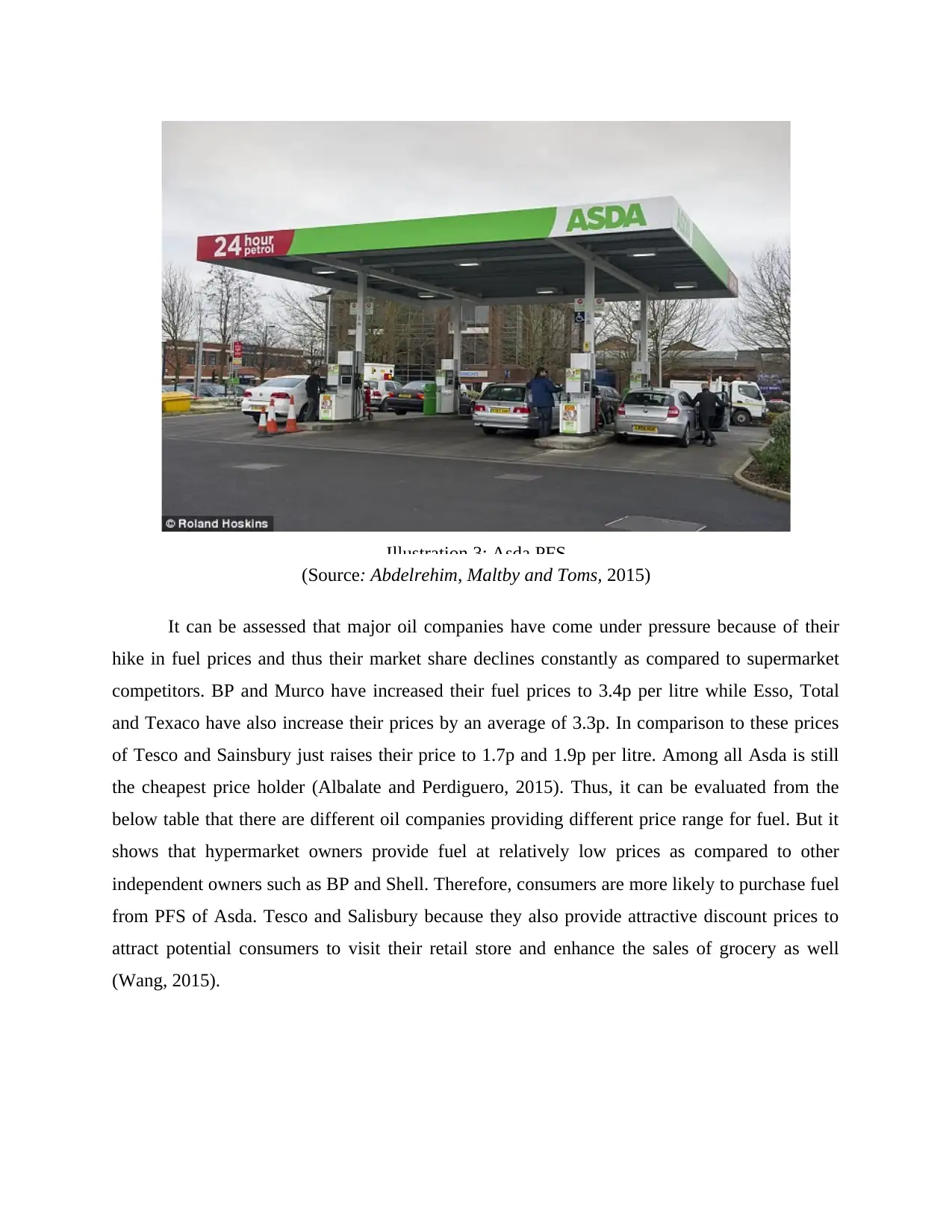
Illustration 3: Asda PFS
(Source: Abdelrehim, Maltby and Toms, 2015)
It can be assessed that major oil companies have come under pressure because of their
hike in fuel prices and thus their market share declines constantly as compared to supermarket
competitors. BP and Murco have increased their fuel prices to 3.4p per litre while Esso, Total
and Texaco have also increase their prices by an average of 3.3p. In comparison to these prices
of Tesco and Sainsbury just raises their price to 1.7p and 1.9p per litre. Among all Asda is still
the cheapest price holder (Albalate and Perdiguero, 2015). Thus, it can be evaluated from the
below table that there are different oil companies providing different price range for fuel. But it
shows that hypermarket owners provide fuel at relatively low prices as compared to other
independent owners such as BP and Shell. Therefore, consumers are more likely to purchase fuel
from PFS of Asda. Tesco and Salisbury because they also provide attractive discount prices to
attract potential consumers to visit their retail store and enhance the sales of grocery as well
(Wang, 2015).
(Source: Abdelrehim, Maltby and Toms, 2015)
It can be assessed that major oil companies have come under pressure because of their
hike in fuel prices and thus their market share declines constantly as compared to supermarket
competitors. BP and Murco have increased their fuel prices to 3.4p per litre while Esso, Total
and Texaco have also increase their prices by an average of 3.3p. In comparison to these prices
of Tesco and Sainsbury just raises their price to 1.7p and 1.9p per litre. Among all Asda is still
the cheapest price holder (Albalate and Perdiguero, 2015). Thus, it can be evaluated from the
below table that there are different oil companies providing different price range for fuel. But it
shows that hypermarket owners provide fuel at relatively low prices as compared to other
independent owners such as BP and Shell. Therefore, consumers are more likely to purchase fuel
from PFS of Asda. Tesco and Salisbury because they also provide attractive discount prices to
attract potential consumers to visit their retail store and enhance the sales of grocery as well
(Wang, 2015).
⊘ This is a preview!⊘
Do you want full access?
Subscribe today to unlock all pages.

Trusted by 1+ million students worldwide
1 out of 19
Related Documents
Your All-in-One AI-Powered Toolkit for Academic Success.
+13062052269
info@desklib.com
Available 24*7 on WhatsApp / Email
![[object Object]](/_next/static/media/star-bottom.7253800d.svg)
Unlock your academic potential
Copyright © 2020–2025 A2Z Services. All Rights Reserved. Developed and managed by ZUCOL.





